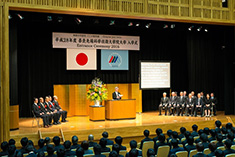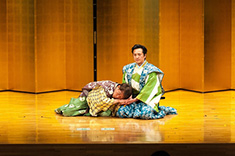2016/04/08
On Tuesday, April 5, 2016, an entrance ceremony was held in the Millennium Hall.
NAIST eagerly promotes admission of students whether from Japan or overseas with strong basic academic capabilities without being bound to a major field in university as well as researchers, engineers and others currently working actively in society who have clearly defined goals and aspirations for the future as well as strong interest and enthusiasm for research fields. This spring 404 graduate students were granted admission to NAIST.
At the ceremony, Mr. Yukikazu Matsutani, the Vice Governor of Nara Prefecture, Mr. Masashi Komurasaki, the Mayor of Ikoma City, Dr. Makoto Nagao, the Director of International Institute for Advanced Studies, Mr. Shigekazu Nakamura, the Executive Director of the Foundation for NAIST, Dr. Shoji Komai, the Head of NAIST Alumni Association were invited as guests. There was a performance of "Neongyoku", Okura School of Kyogen by the Shigeyama Family.
*Number of Enrollees in April
【Master's Course】
Information Science 134 (6 international students)
Biological Sciences 108 (4 international students)
Materials Science 94 (3 international students)
【Doctoral Course】
Information Science 33 (12 international students)
Biological Sciences 15 (2 international students)
Materials Science 20 (4 international students)
Total 404 (31 international students)
Congratulatory Remarks to Entering Students
At Entrance Ceremony, Spring 2016
I would like to extend my heartfelt congratulations to 336 master's program students and 68 doctoral program students who enter NAIST today. On behalf of the 200 faculty and 150 staff members of NAIST, I welcome you all. I would like to express my congratulations to the families of the students, as well.
The new students who enter NAIST today include 31 students from 16 countries around the world. I would like to warmly welcome you, the international students, who have chosen to study at NAIST, away from your home countries. With your entrance, we have a total of 211 international students from 34 countries. NAIST aims to increase its international student population to more than 300 students from more than 40 different countries to achieve an education and research environment where international students are studying and contributing in all of the 60+ laboratories here, and I feel we are very close to realizing this goal.
First, I would like to explain the background of NAIST's foundation. In the concept paper for NAIST establishment, the guiding mission of our research was described as follows.
"Characteristically, the fields of frontier science and technology have wide-ranging, interdisciplinary dimensions in which innovative developments are taking place at a very rapid pace. In these fields, new knowledge from fundamental research leads to technological developments in very short periods, and technological developments, in turn, become the base of fundamental research and make further progress possible. Thus, high integration of science and technology is more pronounced than in any other field. With this in mind, it is crucial to promote interdisciplinary fundamental research that reaches beyond traditional academic divisions in these fields."
NAIST's education mission is stated as follows: "With the rapid developments in areas of frontier science and technology, an important issue for both academic research and industry is the organized fostering of researchers and engineers capable of undertaking research and development in these fields. Especially in these fields, it is necessary to train diverse human resources with refined fundamental scientific skills who can respond flexibly to developments in science and technology, and continuously pursue new research fields."
In short, NAIST was founded to conduct interdisciplinary research in rapidly developing fields of frontier science and technology such as information, biological and materials sciences, by integrating science and technology which extends beyond the borders of established study areas such as engineering, physical science, agriculture and medical science. With this as our foundation, NAIST develops human resources capable of flexibly responding to developments in science and technology, and continually cultivating new areas of research. NAIST's education and research mission, which has since been revised to include the keyword "to see [issues] from a global perspective," was pioneering from the outset and continues to represent the ideas necessary for society today.
With dynamic research by faculty members from various backgrounds, and through organized graduate school education based on cutting-edge research, NAIST has conferred master's degrees and doctoral degrees on 6,911 and 1,310 students respectively. NAIST's research and educational activities have been evaluated very highly both in objective rankings and in the Ministry of Education, Culture, Sports, Science and Technology's (MEXT) evaluation of national university educational and research results. For example, MEXT is now offering intensive support to 22 Japanese institutions with a track record of outstanding research under its Program for Promoting the Enhancement of Research Universities in order to strengthen research prowess. NAIST was one of the institutions chosen.
In addition, while Japanese universities have tended to focus domestically, today we must internationalize ourselves with a view to the future of the world, so that more students and researchers from around the world will study at Japanese universities and learn about Japanese science and technology, while Japanese students need to be exposed to the demands placed on science and technology at the global level and to societies around the world. For this, MEXT launched the Top Global University Project last year. This project is designed to provide priority support for selected universities that focus on increasing their international presence, and I am pleased to note that NAIST is one of the universities selected. I am proud to add that we are one of only 17 Japanese universities selected for both the Program for Promoting the Enhancement of Research Universities and the Top Global University Project. You should be proud of being members of one of the most prestigious universities in Japan in terms of both research and education, and I urge you to take advantage of the valuable opportunities available at NAIST.
Speaking of our educational and research mission, science and technology today is changing dramatically and it can be said that we are in the middle of science and technology revolutions, which will eventually bring great changes to society. New keywords for information science are big data, Internet of Things (IoT) and artificial intelligence. Thanks to computer, sensor and network efficiency improvement, the entire world is now interconnected in real time through the internet, and integrated data use around the world is now possible. We are also entering an era where automobiles and various other products are constantly connected to the internet. As a result, we can also see the rise of a 'Super Smart Society' which integrates the 'cyber world' and the 'real world' through networks connecting everything around us to effectively and thoroughly respond to the various needs of society in offering the necessary materials or services to the necessary people at the necessary time in the necessary amount. Through the development of ICT in various societal infrastructures, not only in 'developed countries', it is possible that new societal systems will emerge.
Revolutions in areas such as genome DNA sequence analysis technology and cellular activity imaging technology have allowed us to collect huge amounts of data on the activities of various cells and living organisms including humans. As a result, the focus in bioscience has shifted from understanding various individual processes to understanding how those processes work collectively and diversely in living organisms and how various living organisms mutually affect each other in the earth's environment. In material science as well, progress in analysis and measurement technology has uncovered a new world of materials and with the elucidation of the behavior of atoms and molecules, the creation of new materials is being actively pursued.
Additionally, it is important to note that, within the rapid developments in science and technology, researchers and technicians in interdisciplinary fields that crossover the three areas of information, biological and materials sciences are being highly sought after. For example, in biological science, with the visualization of various temporal and spatial biomolecular distributions functioning at the cellular and individual level, the data collected from this and genome data have produced big data biology, an interdisciplinary field closely linked to information science. Also with the creation of new materials, the new interdisciplinary field of materials informatics is emerging. Furthermore, the achievement of temporal and spatial resolution in terms of picoseconds and picometers in biomolecule behavior observation has created the fields of chemical biology and picobiology. Developments in cutting edge medical science are expected through the connection of the developments in the construction of medical databases and remote operation technology utilizing virtual reality in information sciences; the development of embedded biodevices utilizing element microminiturization, the introduction of material flexibility and biocompatibility, and the creation of new fluorescent materials and anticancer drugs all within materials science; and the advancements of developmental and cellular biology. With the convergence of fundamental research and application of its results to society, it has been stated that "As a result of the expansion of the frontiers of knowledge, high quality knowledge is constantly emerging at the forefront of research and it becomes difficult to predict which knowledge will lead to the creation of new social value."
Today's global society requires human resources with 'aggressiveness, comprehensive skills and knowledge, integrative abilities, and a global outlook', capable of thinking on their own and creating and utilizing new science and technology, even with no precedent or roadmap to follow.
In order to help create a new world through the development and application of new science and technology at the forefront of society, I hope you will acquire specialized knowledge and a holistic vision in order to respond flexibly to the rapid developments science and technology and continue exploring new areas of research, while nurturing your interdisciplinary and cross-cultural communication and collaboration skills at NAIST.
I hope that all of the new master's program students will embark on ambitious new endeavors. You have left your previous institutions and entered NAIST with various aspirations for further studies in your chosen field or to pursue new research areas. Here at NAIST, no matter which laboratory you join or what area of study you have chosen, a great many possibilities are open to you. Shortly, you will be briefed on research projects being undertaken at laboratories in each graduate school, and I encourage you to consider all the possibilities offered at NAIST, not bound by the knowledge you have acquired and the graduation work you have completed at your previous institutions. By doing so, you may find intriguing research areas that you have neither encountered nor even thought of. As indicated by our motto, "Outgrow Your Limits," NAIST enables you to pursue new challenges to open up your future.
Therefore, it is important for you to remain sensitive to trends in various fields of research and develop the ability to use the results of such research creatively, without being locked into your own area of expertise. While you will all join different laboratories and continue your studies and research at NAIST, you may be able to achieve interesting results by borrowing methods and ideas from other laboratories. NAIST is known for its easy access to all laboratories and graduate schools, so I hope you will interact with people with a wide variety of research interests.
Finally, I hope you will enjoy your life at NAIST in good health, both physically and mentally. In starting your new life here, you will get to meet many people. Build good relationships and personal networks; these will not only expand your range of studies and research, but will also become an invaluable asset for your entire life.
In concluding my message, I hope you will have a successful student life and future beyond.
Congratulations once again on entering NAIST. All members of the faculty and staff welcome you wholeheartedly.
April 5, 2016
Naotake Ogasawara,
President
Nara Institute of Science and Technology








